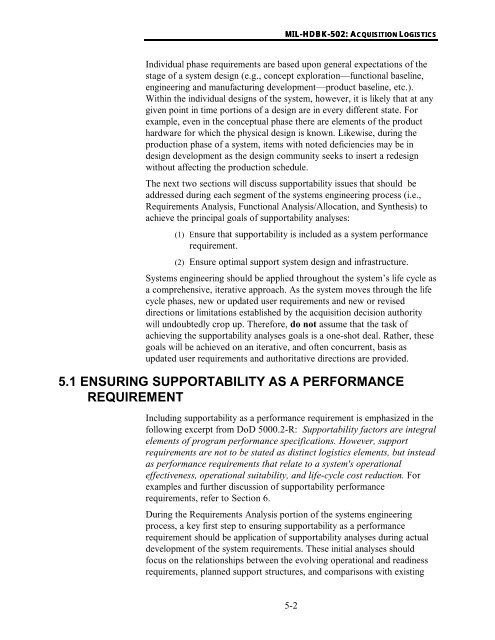MIL-HDBK-502 - Barringer and Associates, Inc.
MIL-HDBK-502 - Barringer and Associates, Inc.
MIL-HDBK-502 - Barringer and Associates, Inc.
Create successful ePaper yourself
Turn your PDF publications into a flip-book with our unique Google optimized e-Paper software.
<strong>MIL</strong>-<strong>HDBK</strong>-<strong>502</strong>: ACQUISITIONALOGISTICSIndividual phase requirements are based upon general expectations of thestage of a system design (e.g., concept exploration—functional baseline,engineering <strong>and</strong> manufacturing development—product baseline, etc.).Within the individual designs of the system, however, it is likely that at anygiven point in time portions of a design are in every different state. Forexample, even in the conceptual phase there are elements of the producthardware for which the physical design is known. Likewise, during theproduction phase of a system, items with noted deficiencies may be indesign development as the design community seeks to insert a redesignwithout affecting the production schedule.The next two sections will discuss supportability issues that should beaddressed during each segment of the systems engineering process (i.e.,Requirements Analysis, Functional Analysis/Allocation, <strong>and</strong> Synthesis) toachieve the principal goals of supportability analyses:(1) Ensure that supportability is included as a system performancerequirement.(2) Ensure optimal support system design <strong>and</strong> infrastructure.Systems engineering should be applied throughout the system’s life cycle asa comprehensive, iterative approach. As the system moves through the lifecycle phases, new or updated user requirements <strong>and</strong> new or reviseddirections or limitations established by the acquisition decision authoritywill undoubtedly crop up. Therefore, do not assume that the task ofachieving the supportability analyses goals is a one-shot deal. Rather, thesegoals will be achieved on an iterative, <strong>and</strong> often concurrent, basis asupdated user requirements <strong>and</strong> authoritative directions are provided.5.1 ENSURING SUPPORTABILITY AS A PERFORMANCEREQUIREMENT<strong>Inc</strong>luding supportability as a performance requirement is emphasized in thefollowing excerpt from DoD 5000.2-R: Supportability factors are integralelements of program performance specifications. However, supportrequirements are not to be stated as distinct logistics elements, but insteadas performance requirements that relate to a system's operationaleffectiveness, operational suitability, <strong>and</strong> life-cycle cost reduction. Forexamples <strong>and</strong> further discussion of supportability performancerequirements, refer to Section 6.During the Requirements Analysis portion of the systems engineeringprocess, a key first step to ensuring supportability as a performancerequirement should be application of supportability analyses during actualdevelopment of the system requirements. These initial analyses shouldfocus on the relationships between the evolving operational <strong>and</strong> readinessrequirements, planned support structures, <strong>and</strong> comparisons with existing5-2
















